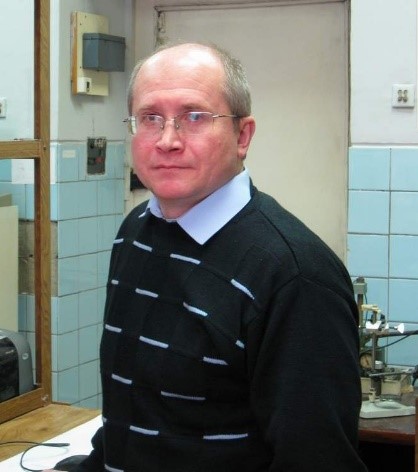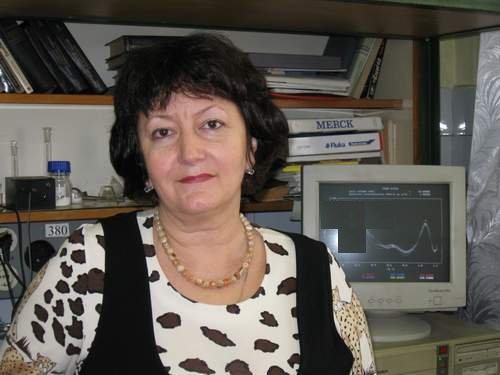The Department of Chemistry of Functional Materials
Prof. Alexander (Oleksandr) A. Pud

since 2009 is the Head of the Department of Chemistry of Functional Materials of the Institute of Bioorganic Chemistry and Petrochemistry of NAS of Ukraine. He graduated from Kyiv Polytechnic Institute, Department of Electrochemical Productions Technology (1979). In 1985 and 2004 he received his PhD degree and Dr. Sci. (HDR) in Polymer Science, at Chemistry Department of Kiev State University, Ukraine respectively. In 2011 he became the Professor in Physical Chemistry. His research interests currently are in fields of chemical and electrochemical synthesis and research of features of formation, properties, structure, morphology and functioning of "smart" hybrid (nano) composites of intrinsically conductive and/or biocompatible conjugated polymers / biopolymers with polymers of other nature, inorganic nanoparticles (semiconductor, dielectric, magnetic, etc.), or with carbonaceous materials (carbon nanotubes, carbon fibers, graphene, etc.); their applications as sensory, conductive, thermosensitive, photoactive and EMI shielding materials, drug delivery carriers in living organisms, sorbents of heavy metal cations and pollutants, etc. https://scholar.google.com.ua/citations?user=a8uQdrsAAAAJ&hl=uk
Dr. Nikolay A. Ogurtsov

graduated from the Lomonosov Moscow State University, Department of Chemistry. In 1991, he received his Ph.D. in chemistry at Pisarzhevsky Institute of Physical Chemistry of the National Academy of Sciences of Ukraine (NASU), Kiev. Since 2001, he is a Senior Researcher in the Department of Chemistry of Functional Materials of the V.P. Kukhar Institute of Bioorganic Chemistry and Petrochemistry of NASU. His current research interests focus on synthesis of nanocomposites based on conducting polymers, the structure–property relationship of such materials.
Dr. Yuriy V. Noskov

currently is a Research Fellow in the Department of Chemistry of Functional Materials of the V.P. Kukhar Institute of Bioorganic Chemistry and Petrochemistry of NAS of Ukraine. He graduated from Kiev Taras Shevchenko National University, Chemical Department (2004). He received a PhD degree in 2010 in Macromolecular Chemistry, at Chemistry Department of Kiev Taras Shevchenko National University (Ukraine). His scientific interests are focused on synthesis of conjugated polymers and their multifunctional hybrid nanocomposites, nanoparticles and their applications as sensor materials, in solar cells drug delivery systems, etc.
Dr. Nataliia V. Davydenko

currently is a Junior Research Fellow in the Department of Chemistry of Functional Materials of the V.P. Kukhar Institute of Bioorganic Chemistry and Petrochemistry of NAS of Ukraine. She graduated from Ivan Franko National University of Lviv, Department of Physical and Colloid Chemistry (2009). She received a PhD degree in 2016 in Physical chemistry at Department of Physical and Colloid Chemistry of Ivan Franko National University of Lviv (Ukraine). Her scientific interests are focused on synthesis of conducting polymers and their nanocomposites, fabrication of gas sensors on the base of these nanocomposites.
Mrs. Iryna E. Myronyuk

currently is a Junior Research Fellow in the Department of Chemistry of Functional Materials of the V.P. Kukhar Institute of Bioorganic Chemistry and Petrochemistry of NAS of Ukraine. She graduated from Kyiv Taras Shevchenko National University, Physical Department (1994). Her research interests are focused on conducting polymers and their hybrid nanocomposites, fabrication of chemical and biosensors on the base of these multifunctional hybrid nanomaterials.
Mrs. Olga S. Kruglyak

currently is an Engineer of the Department of Chemistry of Functional Materials of the V.P. Kukhar Institute of Bioorganic Chemistry and Petrochemistry of NAS of Ukraine. She graduated from Kiev Polytechnic Institute, department of composition materials (1979). Her current research interests are investigations of the gas sensory properties of nanocomposites based on various conductive polymers, detection and quantification of specific gases involved in indoor air or in ambient air.
Department History
In short, the Department story stems from the Laboratory of Electrochemistry of Organic compounds organized in 1987 under leadership Doctor of Chemical Sciences, Prof. Galina Shapoval in the Department of Petrochemistry of the Institute of Physical-Organic Chemistry and Coal Chemistry of Academy of Sciences of the USSR. In 1988 the laboratory headed by Prof. Shapoval was transferred to the Institute of Bioorganic Chemistry (since 1989 - Institute of Bioorganic Chemistry and Petrochemistry). In 1997 the laboratory, which at that time had become quite a powerful research unit, was reorganized into the research Department of Electrochemistry of Organic Compounds of the Institute of Bioorganic Chemistry and Petrochemistry of NAS of Ukraine. Since 2008 the department is headed by Doctor of Chemical Sciences, Professor Alexander (Oleksandr) Pud. Due to a change in scientific directions the Department was renamed to the Department of Chemistry of Functional Materials in 2011.
Since 2008 the department is headed by Doctor of Chemical Sciences, Professor Alexander (Oleksandr) Pud. Due to a change in scientific directions the Department was renamed to the Department of Chemistry of Functional Materials in 2011.
Areas of research, practical orientation of work
Currently, the mainstream of our Department encompasses a wide range of tasks related to the synthesis, research and applications of conjugated biocompatible polymers (including intrinsically conducting polymers) and their composites. In particular, our efforts are aimed at:
• synthesis and research of features of formation, properties, structure, morphology and functioning of "smart" hybrid (nano) composites of electrically conductive and biocompatible conjugated polymers / biopolymers with polymers of other nature, inorganic nanoparticles (semiconductor, dielectric, magnetic, etc.), or with carbonaceous materials (carbon nanotubes, carbon fibers, graphene, etc.);
• research and control of specific interactions, structure and state of electrically conductive and biocompatible polymers along the interface with inorganic and polymeric templates / matrices, as well as with environmental components;
• study of the effectiveness of synthesized / formed nanocomposites of electrically conductive and biocompatible conjugated polymers as sensory, conductive, thermosensitive, photoactive and EMI shielding materials, drug delivery carriers in living organisms, sorbents of heavy metal cations and pollutants, etc.;
• finding peculiarities of transformations of synthesized/formed components of electrically conductive and biocompatible hybrid materials in heterophase systems.
• study of the effectiveness of synthesized / formed nanocomposites of electrically conductive and biocompatible conjugated polymers as sensory, conductive, thermosensitive, photoactive and EMI shielding materials, drug delivery carriers in living organisms, sorbents of heavy metal cations and pollutants, etc.;
Current projects
Internal
1. “Synthesis, properties and specific interactions of new "smart" hybrid nanocomposites
It has been performing in the frame of the NASU program of fundamental research (2022 – 2026)
2. Development of intelligent sensory system with sensitive elements based on hybrid conducting nanocomposites for the registration of environmentally harmful volatile compounds (2018-2022)
Granted by NAS of Ukraine, in the frame of Scientific Technical Program “Smart sensor devices of a new generation based on modern materials and technologies”.
The project is performed in collaboration with V.E. Lashkaryov Institute of Semiconductor Physics of NAS of Ukraine.
It is directed to develop an intelligent sensor electronic system, which includes chemoresistive sensitive elements based on hybrid conducting nanocomposites. The final system will register the responses from the sensor array with these nanocomposites to environmentally harmful volatile compounds (ammonia, volatile organic compounds (VOC) namely organic acids and solvents). The developed conducting core-shell nanocomposites consist of the shell of intrinsically conducting polymer (mainly polyaniline or its copolymers) synthesized in a presence of core nanoparticles (inorganic aluminosilicate nanotubes, dielectric polymer nanoparticles). The selected nanocomposites with high conductivity will be used to prepare and study their percolation nanocomposites with dielectric polymers to use them in the sensor arrays for ammonia and mentioned above VOC.
International
Project G5757 “Smart Nanomaterials and a Soldier Alarm Badge to Detect Toxic Gases by mobile Devices”
Granted by NATO in the framework of the Science for Peace and Security (SPS) Program Akronim NanoDeTox
It is performed in collaboration with:
Prof. Jean-Luc Wojkiewicz, IMT Lille Douai
Dr. Cyril Lahuec, IMT Atlantique, Dept. Electronics, Plouzane, France
DrSc. Oleksandr Kukla, V.E. Lashkaryov Institute of Semiconductor Physics, NASU, Kyiv, Ukraine
The main objective of the project is to develop the new smart wearable alarm light-weight soldier badge which uses as new smart nanomaterials to detect the toxic gases.
Some earlier projects
Internal:
1. The project “Investigations and development of sensors based on films of conductive polymer materials” in the frame of the NASU program of fundamental research „Investigations in fields of sensor systems and technologies” (2004-2006).
2. The project “Sensor system based on polyaniline composite for registration of substances with acid and base properties” of the target complex scientific-technical program “Sensory systems for medical–ecological and industrial–technological problems” of NASU (2007-2012).
3. The project “Synthesis and study of hybrid nanocomposites based on conducting polymers with controlled structure and properties” of the target complex program of fundamental research of NASU "Fundamental problems of nanostructured systems, nanomaterials, nanotechnologies" (2010-2014).
4. The project “Fundamental aspects of the synthesis and structure-property relationships of multifunctional nanostructured hybrid materials based on conducting polymers and carbon nanotubes” of complex the NASU program of fundamental research “Fundamental problems of making new substances and materials of chemical industry” (2012-2016).
5. The project “The formation, properties and interactions of nanocomposites of conducting polymers and bioactive compounds in heterophase systems” in the frame of the NASU program of fundamental research (2013-2017)
6. The collaborative project “Development, testing and metrological certification of sensor system based on composites of electrically conductive polymers for registration of substances with basic and acidic properties. Development and optimization of sensitive materials based on composites of electrically conductive polymers with polymeric dielectrics and inorganic semiconductors” of the target complex program of NASU “Sensing devices for medical – ecological and industrial–technological problems: metrology support and trial operation” (2013-2017).
7. The project “Peculiarities of synthesis, structure and interphase interactions as systemic factors influencing functional properties of new hybrid materials based on the biocompatible polymers and substances of biological origin” in the frame of the NASU program of fundamental research (2018 – 2021).
8. The project “New nanostructured polymer-based hybrid composites for environmental monitoring and protection” of the NASU Program of Fundamental Research ‘‘New Functional Substances and Materials for Chemical Engineering’’ (2017-2021).
International:
1. Project #3746 “Hybrid organic-inorganic heterostructures for photovoltaic devices” granted by STCU (2007-2008).
2. Set of Projects “Conducting polymer composites” (P100, P100a, P100b) with company Atofina (France) as partner projects in the frame of the Science and Technology Center in Ukraine ((STSU) (2002-2004).
3. The project “To investigate the corrosion inhibiting effects of intrinsically conductive polymers, particularly polyaniline compositions on steel and aluminum substrates” with the company PPG Industries, Inc (USA) (1997-1998)
Collaboration with Research Institutions
- IMT Lille Douai, Institut Mines-Télécom, Univ Lille, Centre for Environment and Energy (France)
- IMT Atlantique, OPT Department; Technopôle Brest-Iroise (France)
- Department of functional transducers for sensory technology, V.E.Lashkaryov Institute of Semiconductor Physics, NAS of Ukraine
- Department of Environmental Engineering and Earth Sciences, Clemson University, Clemson (USA)
- Department of Chemistry of Macromolecular Compounds Taras Shevchenko National University of Kyiv
The main theoretical and practical results, the most important publications
“The Impact of Interfacial Interactions on Structural, Electronic and Sensing Properties of Poly(3‐methylthiophene) in the Core‐shell Nanocomposites Application to the CWA Simulants Detection”, N.A. Ogurtsov, A.V. Mamykin, O.L. Kukla, A.S. Pavluchenko, M.V. Borysenko, Yu.P. Piryatinski, J.-Luc Wojkiewicz, A.A. Pud, Macromolecular Materials and Engineering
DOI: 10.1002/mame.202100762
“Synthesis and properties of core–shell halloysite–polyaniline nanocomposites”, Yu. Noskov, N. Ogurtsov, V. Bliznyuk, Yu. Lvov, I. Myronyuk, A. Pud, Applied Nanoscience, 2021.
DOI: 10.1007/s13204-021-01812-9
“Specific interactions and charge transport in ternary PVDF/polyaniline/MWCNT nanocomposite films”, R.M. Rudenko, O.O. Voitsihovska, V.M. Poroshin, M.V. Petrychuk, S.P. Pavlyuk, A.S. Nikolenko, N.A. Ogurtsov, Yu.V. Noskov, D.O. Sydorov, A.A. Pud, Composites Science and Technology 2020, 198, 108284.
DOI: 10.1016/j.compscitech.2020.108284
“Thermosensitive ternary core–shell nanocomposites of polystyrene, poly(N-isopropylacrylamide) and polyaniline”, L.O. Vretik, Yu.V. Noskov, N.A. Ogurtsov, O.A. Nikolaeva, A.V. Shevchenko, A. I. Marynin, M. S. Kharchuk, O. M. Chepurna, T. Y. Ohulchanskyy, A. A. Pud, Applied Nanoscience 2020, 10, 4951–4964.
DOI: 10.1007/s13204-020-01424-9
“On the importance of interface interactions in core-shell nanocomposites of intrinsically conducting polymers”, A.A. Pud, N.A. Ogurtsov, Yu.V. Noskov, S.D. Mikhaylov, Yu.P. Piryatinski, V.N. Bliznyuk, Semiconductor Physics, Quantum Electronics & Optoelectronics 2019, 22, 470-478.
DOI: 10.15407/spqeo22.04.470
“Polyaniline Doping by α, α-Difluoro-β-amino Acids”, Yu. Noskov, A. Sorochinsky, V. Kukhar, A. Pud, ACS Omega 2019, 4, 7400-7410.
DOI: 10.1021/acsomega.9b00207
“High effectiveness of pure polydopamine in extraction of uranium and plutonium from groundwater and seawater”, V.N. Bliznyuk, K. Kołacińska, A.A. Pud, N.A. Ogurtsov, Yu.V. Noskov, B.A. Powell, T.A. DeVol, RSC Advances 2019, 9, 30052-30063 1.
DOI: 10.1039/C9RA06392G
Polyaniline nanocomposites based sensor array for breath ammonia analysis. Portable e-nose approach to non-invasive diagnosis of chronic kidney disease
P Le Maout, JL Wojkiewicz, N Redon, C Lahuec, F Seguin, L Dupont, Sergei Mikhaylov, YuriyNoskov, NikolayOgurtsov, AlexanderPud
Sensors and Actuators B: Chemical 274, 616-626 31 2018
DOI: 10.1016/j.snb.2018.07.178
“Effect of the dopant anion and oxidant on the structure and properties of nanocomposites of polypyrrole and carbon nanotubes”, NA Ogurtsov, YV Noskov, OS Kruglyak, SI Bohvan, VV Klepko, M.V. Petrychuk, A.A. Pud, Theoretical and Experimental Chemistry 2018, 54, 114-121.
DOI: 10.1007/s11237-018-9554-x
“Poly (vinylidene fluoride)/poly (3-methylthiophene) core–shell nanocomposites with improved structural and electronic properties of the conducting polymer component”, N.A. Ogurtsov, V.N. Bliznyuk, A.V. Mamykin, O.L. Kukla, Yu.P. Piryatinski, A.A. Pud, Physical Chemistry Chemical Physics 2018, 20), 6450-6461.
DOI: 10.1039/C7CP07604E
“New nanocomposites of polystyrene with polyaniline doped with lauryl sulfuric acid”, A.A. Pud, O.A. Nikolayeva, L.O. Vretik, Yu.V. Noskov, N.A. Ogurtsov, O.S. Kruglyak, E.A. Fedorenko, Nanoscale research letters 2017, 12, 493.
DOI: 10.1186/s11671-017-2265-8
“UV-light induced solid-phase photodegradation in PANI nanocomposites”, S. Mikhaylov, A. Pud, J.-L. Wojkiewicz, P. Coddeville, 2017 IEEE 7th International Conference Nanomaterials: Application & Properties (NAP), 2017, 03NNSA09-1-03NNSA09-4.
DOI: 10.1109/NAP.2017.8190257
“Influence of dispersed nanoparticles on the kinetics of formation and molecular mass of polyaniline”, N.A. Ogurtsov, S.D. Mikhaylov, P. Coddeville, J.-L. Wojkiewicz, G.V. Dudarenko, A.A. Pud, The Journal of Physical Chemistry B 2016, 120, 10106-10113.
DOI: 10.1021/acs.jpcb.6b05944
“Acid-dopant effects in the formation and properties of polycarbonate-polyaniline composites”, Yu. Noskov, S. Mikhaylov, P. Coddeville, J.-L. Wojkiewicz, A. Pud, Synthetic Metals 2016, 217, 266-275.
DOI: 10.1016/j.synthmet.2016.04.015
“The PANI-DBSA content and dispersing solvent as influencing parameters in sensing performances of TiO2/PANI-DBSA hybrid nanocomposites to ammonia”, S. Mikhaylov, N.A. Ogurtsov, N. Redon, P. Coddeville, J.-L. Wojkiewicz, A. Pud, RSC Advances 2016, 6, 82625-82634.
DOI: 10.1039/C6RA12693F
“Evolution and Interdependence of Structure and Properties of Nanocomposites of Multiwall Carbon Nanotubes with Polyaniline”, N.A. Ogurtsov, Yu.V. Noskov, V.N. Bliznyuk, V.G. Ilyin, J.-L. Wojkiewicz, E.A. Fedorenko, A.A. Pud, The Journal of Physical Chemistry C 201, 120, 230-242.
DOI: 10.1021/acs.jpcc.5b08524
“Anion-chromic” interactions of emeraldine base with hydroxide and halide anions in the solid polymer matrix”, A. Pud, I. Duboriz, Yu. Piryatinski, O. Dimitriev, Synthetic Metals 2015, 209, 232-239.
DOI: 10.1016/j.synthmet.2015.07.034
“Effect of multiwalled carbon nanotubes on the kinetics of the aniline polymerization: the semi-quantitative OCP approach”, N.A. Ogurtsov, Yu.V. Noskov, A.A. Pud, The Journal of Physical Chemistry B 2015, 119, 5055-5061.
DOI: 10.1021/jp511665q
“Ammonia/amine electronic gas sensors based on hybrid polyaniline–TiO2 nanocomposites. The effects of titania and the surface active doping acid”, S Mikhaylov, N Ogurtsov, Y Noskov, N Redon, P Coddeville, J.-L. Wojkiewicz, A. Pud, RSC Advances 2015, 5, 20218-20226.
DOI: 10.1039/C4RA16121A
“Polyaniline/poly(ethylene terephthalate) film as a new optical sensing material”, Ie. Duboriz, A. Pud, Sensors and Actuators B, 2014, 190, 398–407.
DOI: 10.1016/j.snb.2013.09.005
“Poly(3-methylthiophene)–polyaniline couple spectroelectrochemistry revisited for the complementary red–green–blue electrochromic device”, D. Sydorov, Ie. Duboriz, A. Pud, Electrochimica Acta, 2013, 106, 114–120.
DOI: 10.1016/j.electacta.2013.05.071
“Deep Impact of the Template on Molecular Weight, Structure, and Oxidation State of the Formed Polyaniline”, N.A. Ogurtsov, Yu.V. Noskov, K.Yu. Fatyeyeva, V.G. Ilyin, G.V. Dudarenko, A.A. Pud, Journal of Physical Chemistry B, 2013, 117, 5306–5314.
DOI: 10.1021/jp311898v
“Electrochemically assembled planar hybrid poly (3-methylthiophene)/ZnO nanostructured composites”, D. Sydorov, P. Smertenko, Yu. Piryatinski, T. Yoshida, A. Pud, Electrochimica Acta, 2012, V.81, P. 83– 89.
DOI: 10.1016/j.electacta.2012.07.076
“Tuning of the charge and energy transfer in ternary CdSe/poly (3-methylthiophene)/poly (3-hexylthiophene) nanocomposite system”, Dimitriev O.P., Ogurtsov N.A., Li Y, Pud A.A., Gigli G., Smertenko P.S., Piryatinski Y.P., Noskov Y.V, Kutsenko A.S.Colloid & Polymer Science, 2012, 290, 1145–1156.
DOI: 10.1007/s00396-012-2632-z
“Nanostructured polyaniline-based composites for ppb range ammonia sensing”, J.-L. Wojkiewicz, V.N. Bliznyuk, S. Carquigny, N. Elkamchi, N. Redon, T. Lasri, A.A. Pud, S. Reynaud, Sens. Actuators B, 2011, V. 160, No. 1, P. 1394-1403,
DOI: 10.1016/j.snb.2011.09.084
“Evidence of the controlled interaction between PEDOT and PSS in the PEDOT:PSS complex via concentration changes of the complex solution”, O.P. Dimitriev, Yu.P. Piryatinski, A.A. Pud, The Journal of Physical Chemistry B, 2011, 115, No. 6, P. 1357-1362
DOI: 10.1021/jp110545t
“Synthesis and properties of hybrid poly(3-methylthiophene)-CdSe nanocomposite and estimation of its photovoltaic ability”, N.A. Ogurtsov, A.A. Pud, O.P. Dimitriev, Yu.P. Piryatinski, P.S. Smertenko, Yu.V. Noskov, O.S. Kutsenko, Molecular Crystals and Liquid Crystals 2011, 536, 33-40.
DOI: 10.1080/15421406.2011.538330
“Ternary magnetic nanocomposite based on core–shell Fe3O4/polyaniline nanoparticles distributed in PVDF matrix”, M. Petrychuk, V. Kovalenko, A. Pud, N. Ogurtsov, A. Gubin, Phys. Status Solidi A 2010, 207, 442-447.
DOI: 10.1002/pssa.200824421
PEDOT-PSS films: effect of organic solvent additives and annealing on the film conductivity ,Synthetic Metals, 2009, 159, 2237-2239,Dimitriev O.P., Grinko D., Noskov Yu.V., Ogurtsov N. A., Pud A.A.
DOI:10.1016/j.synthmet.2009.08.022
“New aspects of the low concentrated aniline polymerization in the solution and in SiC nanocrystals dispersion”, A.A. Pud, Yu. V. Noskov, A.Kassiba A., K. Yu. Fatyeyeva, N. A. Ogurtsov, M. Makowska-Jausik, W. Bednarski, M. Tabellout, G.S. Shapoval, J. Phys. Chem., B, 2007, 111, 2174-2180.
DOI: 10.1021/jp0656025
“Corrosion inhibition of aluminium alloy in chloride mediums by undoped and doped forms of polyaniline” N.A. Ogurtsov, A.A. Pud, P. Kamarchik, G.S. Shapoval, Synthetic Metals, 2004, 143, 143-147.
DOI: /10.1016/j.synthmet.2003.10.015
“Some aspects of preparation methods and properties of polyaniline blends and composites with organic polymers”, A.A. Pud, N.A. Ogurtsov, A.Korzhenko, G.S. Shapoval, Prog. Polym. Sci., 2003, 28, 1701-1753.
DOI: 10.1016/j.progpolymsci.2003.08.001
“The poly(ethylene terephthalate)/polyaniline composite: AFM, DRS and EPR investigations of some doping effects”, A.A. Pud, M. Tabellout, A. Kassiba, A.A. Korzhenko, S.P. Rogalsky, G.S. Shapoval, F. Houzé, O. Schneegans, J. R. Emery, J. Mater. Sci. 2001, 36, 3355–3363.
DOI: 10.1023/A:1017983206220
“Reactions at the lower potential limit in aprotic medium at a platinum cathode revisited: their role in indirect electrochemical reductive degradation of polymers” A.A. Pud, S.P. Rogalsky, G.S. Shapoval”, J. Electroanal. Chem. 2000, 480, 1-8.
DOI: 10.1016/S0022-0728(99)00437-4
“Reactions and stability of fluorinated poly(vinyl trimethylsilane) in electrochemical systems” Polymer, A.A. Pud, S.P. Rogalsky, G.S. Shapoval, A.P. Kharitonov, V.V.Teplyakov, H. Strathmann, F. Poncin-Epaillard, 2001, 42, 1907-1913.
DOI: 10.1016/S0032-3861(00)00576-0
“Electrochemical stability and transformations of fluorinated poly(2,6-dimethyl-1,4-phenylene oxide)” A.A. Pud, S.P. Rogalsky, G.S. Shapoval, A.P. Kharitonov, A. Kemperman, Polymer Degradation and Stability, 2000, 70, 409-415.
DOI: 1016/S0141-3910(00)00135-X
“The polyaniline/poly(ethylene terephtalate) composite. 1.Peculiarities of the matrix aniline redox polymerization”, A.A. Pud, S.P. Rogalsky, G.S. Shapoval, A.A. Korzhenko, Synthetic Metals, 1999, 99, 175-179.
DOI: 10.1016/S0379-6779(98)01478-7
“Electrochemical behaviour of mild steel coated by polyaniline doped with organic sulfonic acids”, A.A. Pud, G.S. Shapoval, P. Kamarchik, N.A. Ogurtsov, V.F. Gromovaya, I.E. Myronyuk, Yu. V. Kontsur, Synthetic Metals, 1999, V.107, №2, P.111-115
DOI: 10.1016/S0379-6779(99)00155-1
“Electrochemical resistance and degradation of fluorinated polyolefines”, A. Pud, Surface Coatings International, 1998, Vol.81, N6, P.292-296
DOI: 10.1007/BF02700554
“Electrochemical reduction of some saturated and unsaturated perfluorocarbons”, A.A. Pud, G.S.Shapoval , V.P. Kukhar, O.E. Mikulina, L.L. Gervits, Electrochimica Acta, 1995, 40, 1157-1164.
DOI: 10.1016/0013-4686(95)00030-I
“Electrochemistry as the way to transform polymers”, A.A. Pud, G.S. Shapoval, Macromolar Reports,1995 A 32, № 5&6. P.629-639.
DOI: 10.1080/10601329508018952
“Stability and degradation of conducting polymers in electrochemical systems”, A.Pud, Synthetic Metals, 1994, 66, 1-18.
DOI: 10.1016/0379-6779(94)90155-4


